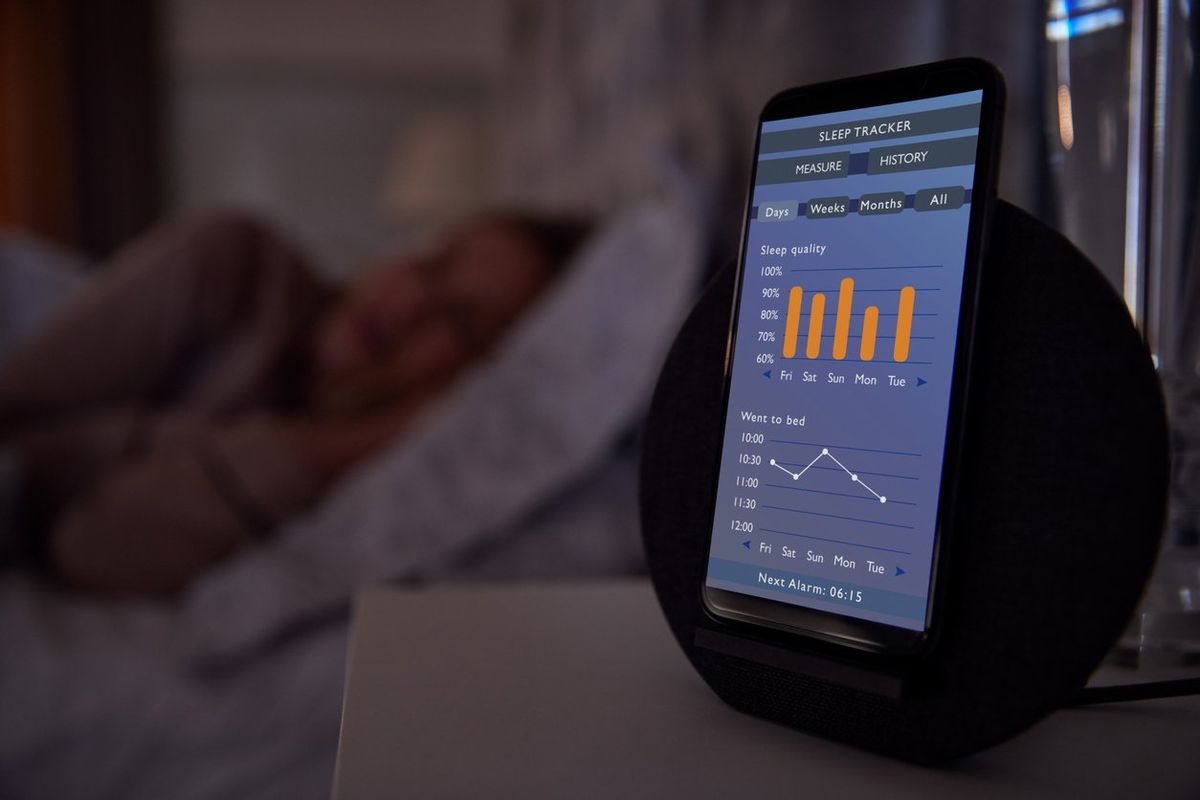March is National Sleep Awareness Month.
Sleep … elusive sleep. It’s a much needed, yet somehow complicated part of life, especially if you’re perimenopausal. Luckily, like so many things these days, we have technology to help us figure it out. Enter sleep trackers.
A lot of people use smartwatches to track their sleep. But some people (OK, me) don’t like wearing a smartwatch to bed. It just feels odd — like it should go home to a jewelry box at the end of the day. But if that happened, how would I know my sleep score? How would I feel superior to my partner because of said sleep score? What would I talk about? (OK, these are problems for another time.)
It turns out there are many wrist-free devices out there to help analyze sleep. From an 80s-style headband to a thin mat tucked under the mattress, technology is stepping up its game in the name of good sleep.
If you’ve never tracked your sleep cycle and are wondering what all the fuss is about, sleep trackers can provide important insight on your quality of sleep. If you’re waking up tired but not sure why, a sleep tracker can help you understand what’s going on.
For example, people with sleep apnea may not know that they have it but it’s really dangerous because it causes irregular breathing or can even stop you from breathing while you’re asleep. If left untreated, sleep apnea increases the risk for cardiovascular disease and other serious health conditions.
About 1 in 10 women in the U.S. have sleep apnea. And now there’s a tracker for that: Samsung recently added a sleep apnea detection feature to its health monitor app for the Samsung Galaxy watch. The feature was approved by the FDA in February — a first for the sleep tracking industry and a step forward in awareness for sleep disorders.
Read: The Day After a Bad Day’s Sleep >>
Sleep trackers also can help you and your healthcare provider identify underlying health conditions and lifestyle choices that may have a negative impact on your sleep. In honor of sleep awareness month, here are some unique, wrist-free devices to consider.
Headbands
Brain sensors are the secret ingredient to these smart headbands.The Muse headband (around $450) analyzes activity in the brain and then plays calming sounds through headphones to help you sleep. On-demand analysis, sleep scores and personal guidance are some of the takeaways when using the headband. Philips SmartSleep Deep Sleep Headband ($399.99) has two sensors to detect when you’re in deep sleep. The algorithm then prompts slow waves of audio to improve quality of sleep. Fun fact: the headband was picked by a NASA-funded institute for studies to help improve sleep for astronauts.
Rings
Smart rings track your sleep like your smartwatch but from a band around your finger. Advanced sleep tracking options include the Oura Ring (from $299) and the SleepOn Go2sleep ($89). The titanium Oura Ring is so woke it can tell if your late-night snack or activity had an impact on your quality of sleep. The ring also measures blood oxygen levels and offers personalized tips to improve your sleep score. Unintentional bonus: The Oura Ring will hold your finger when you’ve had a bad dream. Speaking of aliens, the AI powered Go2sleep ring gives serious UFO vibes. The oval-shaped tracker is worn on the palm-side of your hand where sensors monitor sleep by the second for a more comprehensive look at patterns and possible problems. The detailed reports help you understand what it all means. For people who don’t want to put a ring on it, the Go2sleep SE goes on your fingertip.
Mats
Anti-wearable? Pro-simplicity? A sleep tracking mat is probably for you. Just place the mat under your mattress or mattress topper, hop into bed and catch some ZZZs. The sensors in the mat will track important details such as respiratory rate and heart rate while you sleep. For added perks, the Sleep Tracking Mat from Withings ($129) has a snore detector and a home automation option so you can control lights and other smart home devices when you get in and out of bed. If hot flashes are keeping you up at night, or you just run warm, the Chilipad Dock Pro Sleep System ($199) uses AI to adjust the bed temperature in real time.
Bedside smart devices
For something you don’t have to put on or worry about after a quick set up, an all-in-one sleep-tracking device can be a good option. Google Nest Hub ($79.99 per year) offers a Sleep Sensing feature that uses a miniature radar to detect motion. Basically, from your device on the side of your bed, it knows when you’re tossing and turning. It also features microphones to capture snoring and respiratory problems and light and temperature sensors. The next morning, a summary and tips for better sleep will be ready on the display. Your smartphone can also count as a bedside sleep tracker. For example, the free SleepScore and ShutEye apps record breathing and report results in the morning. And we know a good night’s sleep can lead to feeling refreshed in the morning. Sweet dreams!







